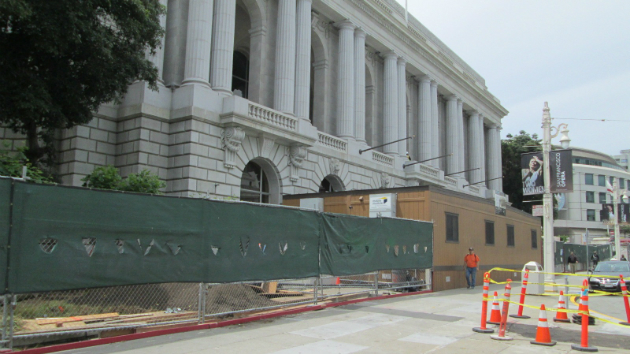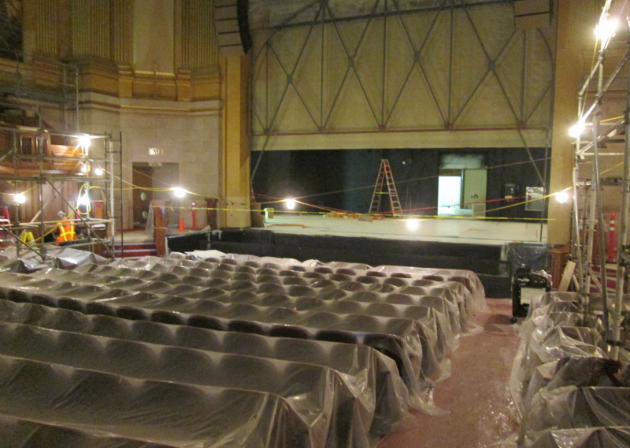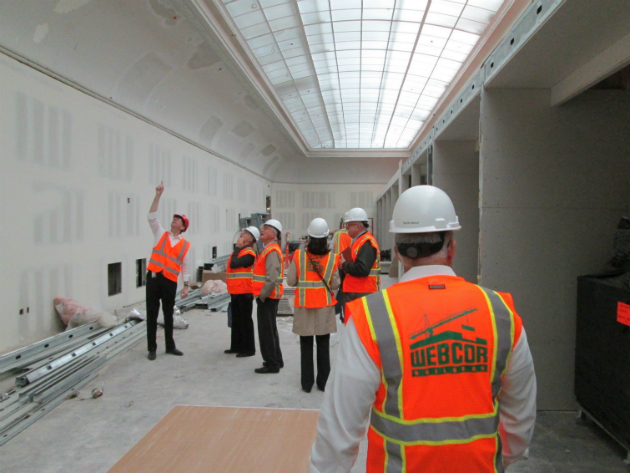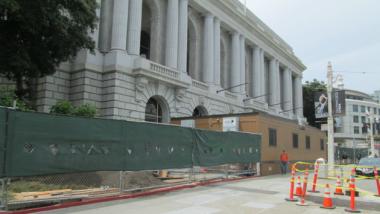
When Arthur Brown Jr.'s 1932 Veterans Memorial Building, the War Memorial Opera House's twin, closed for seismic retrofitting and a major restoration two years ago, many Bay Area performing arts organizations lost their San Francisco performance space.
The unavailability of the 900-seat Herbst Theatre was especially a challenge for San Francisco Performances, Philharmonia Baroque, and a dozen other organizations using the facility regularly. Two of the substitutes in the area, the concert halls at the S.F. Conservatory of Music and SFJAZZ, each has less seating capacity and (some would say) inferior acoustics.
At long last, completion of the renovation project is just around the corner, a bit behind the original July 1 target date, but not by much. What the city is getting this fall is substantially a new building, safer and better than ever before, with major additional features.
A quick tour of the construction site, led by Wilsey Center project manager Michael Simpson, who, in his spare time, is San Francisco Opera's CFO, showed most of what has been done. The project manager for the building is Tara Lamont, from the S.F. Department of Public Works; Andrew Maloney, DPW Building Design & Construction, is the project architect; Ron Hamburger, SGH, is the structural engineer; James Ng is engineering supervisor.
The fixed-base seismic upgrade (the same used for the Opera House, but different from City Hall's base-isolated approach), provides lateral strength as new concrete shear walls replace much of the original, brittle, hollow clay tile walls and Sheetrock. All electrical, mechanical, and plumbing systems have been replaced. The building will have a new, comprehensive fire alarm and sprinkle system.
To begin with Herbst, this multi-purpose theater is due to reopen at the end of September or early October, yet to be decided. Other performing arts organizations will soon follow, but some may make their new venues permanent. City Arts & Lectures will continue to use the Nourse Theater, which it renovated during the Herbst closure.

Audiences will not see many changes at Herbst Theater beyond new paint, regilding, and side boxes that have been reconfigured for better sightlines. But the stage has been expanded, with new wing space, new rigging, and an orchestra pit, complete with a pit lift. For artists, it will be a whole new ballgame. Herbst has always been suitable for chamber music, recitals, and lectures, but for dancers, small orchestras, and large numbers of performers, there was no real backstage, and a dearth of dressing rooms and other basic facilities.
All of that now exists aplenty: Taking over the North-South corridor between the back of the theater and the wall facing Franklin St., the new backstage area has been enlarged and redesigned.
There is no way to tell at this point how Herbst's acoustics will sound, but former S.F. Symphony General Manager Peter Pasterich and acoustician Larry Kirkegaard had already made changes before closure to improve the sound. On this project, Kurt Graffy from Arup, an independent, local design firm, was consulted on acoustic decisions during reconstruction. The overall theater consultant for Herbst is Auerbach, Pollock, Friedlander.
More of historical than of aesthetic importance, the Frank Brangwyn murals, originally painted for the 1915 Panama-Pacific International Exposition, are still decorating the walls. They have been restored in time for the Exposition's centennial.
The Green Room above Herbst, used for some chamber performances, is part of the reconstruction, but its unacceptable acoustics have not been redone.
The big news from the building, of course, is the Diane B. Wilsey Center for Opera, one of David Gockley's most important accomplishments during his decade as the opera's general director.
Succeeding former occupants, such as SFMOMA and PALM, now renamed the Museum of Performance and Design, on the building's grand fourth floor, the company will have a 299-seat theater for chamber opera and recitals, in addition to consolidating some of S.F. Opera's previously scattered facilities. Mark Cavagnero is architect for the Wilsey Center, working in cooperation with Meyer Sound. The Opera's share of space on the fourth floor and in the basement will house:
- Dianne and Tad Taube Atrium Theater
- Norby Anderson Costume Studio
- John M. Bryan Education Studio
- Hume Family Gallery
- Edward Paul Braby San Francisco Opera Archive
- Barbara Moller Ward Lobby (the lobby for the Atrium Theater, not for the building)
- William W. Godward Canteen
In addition to the regular building elevators, the Wilsey Center will have additional elevators (passenger and freight) on the McAllister St. side.
There is one bit of design bad news: The building's spectacular skylight (which was blacked out with tar during World War II, and not restored for four decades after) is being covered up in the center of the space, where the theater will be. This time the perfectly sensible, yet disappointing reason is to control lighting for performances.

Because of the number of organizations involved (including construction firms, hundreds of vendors, federal, state, and city administrations, and private donors), varying definitions of which costs to include beyond construction, the project cost estimates vary widely, so the following figures are presented with the caveat that no single, agreed-upon number exists and work is not yet completed.
For the Veterans Building, the original Department of Public Works estimate of $96.5 million has gone up to $128 million, excluding the San Francisco Opera's $21 million share for the Wilsey Center. For the sake of comparison, the Department of Public Works reported the cost of the seismic upgrades and repair of the War Memorial Opera House at $75 million. I covered that story from beginning to end and have seen no other figure of that cost under $95 million. The entire, humongous Civic Center seismic reconstruction project itself is a prime example of uncertainty, estimated by many sources to be around $1 billion.
Corrections and updates, June 10: Article now identifies more of the project team and elaborates on the seismic upgrade and additions. The opening date for Herbst was corrected, as it is yet to be decided.

